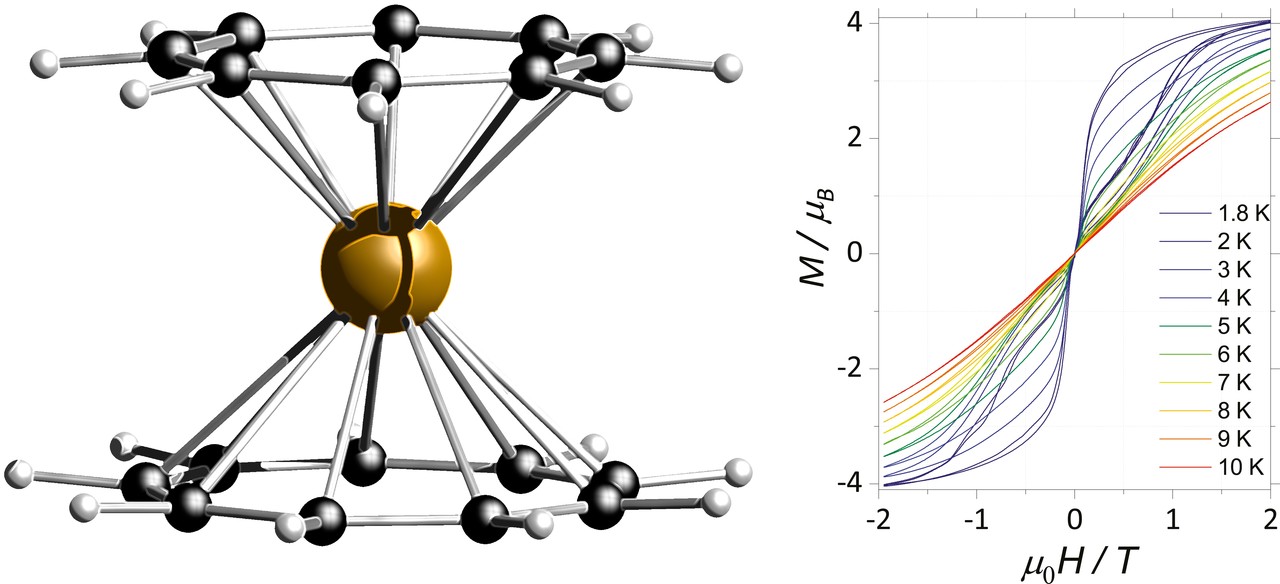
Sandwich complexes bear exclusively two planar, cyclic and π-bonded ligands. Since their discovery in the 1950s, sandwich complexes became one of the key compounds in modern organometallic chemistry yielding a plethora of ground-breaking findings for both, research and application. Ever since the quest for new sandwich complexes has been a central part of modern organometallic chemistry. Despite the large variety of possible ligand permutations, considering ring sizes from 3-9 atoms, only a limited number ligand combination has been realized.
Very recently, the field of sandwich compounds began flourishing once more with the rise of 4f-element based Single-Molecule Magnets (SMM). This certainly peaked in the synthesis of a dysprosocenium SMM showing magnetic hysteresis up to 80 K. This does in principle allow maintaining the SMMs properties at liquid nitrogen temperatures and thus was an incredibly huge step towards the application of SMMs in dense data storage or quantum spintronic devices. This finding is in line with a popular model for the SMM behaviour of mononuclear lanthanide complexes, that focuses on the stabilization of the corresponding lanthanide ions magnetic properties by tuning the local electron density around the lanthanide ion generated by the ligand sphere. The two most prominent examples of this approach are dysprosium and erbium. While an axial ligand field is favourable for the SMM properties of dysprosium complexes, an equatorial ligand field is beneficial in the case of erbium. The latter can be achieved by introducing large co-planar ligands, which exert a strong equatorial ligand field, into the coordination sphere of erbium ions.
In our contribution, we present a new class of pure sandwich complexes ([(η9-C9H9)Ln(η8-C8H8)]), which exclusively contain fully π-coordinated coplanar eight and nine-membered CH rings. Streitwieser, who discovered the landmark sandwich compound uranocene, already attempted the synthesis of these compounds as early as in 1973. According to his report, it was not possible to simultaneously introduce a η8-C8H8 and η9‑C9H9 moiety, which is exactly what have achieved now. After reassessing the whole synthetic protocol, we decided that it would still be worth the effort and started preparing the necessary educts. Luckily, it turned out to be possible to prepare the targeted [(η9-C9H9)Ln(η8-C8H8)] compounds in a rather convenient way across the 4f series. Moreover, we could prove the SMM character of the erbium(III) analogue by magnetometric studies, as predicted from above-described model. Aside from this, a detailed Raman spectroscopic analysis allowed us to add some insight into the vibrational behavior of the η9‑C9H9 moiety, that nicely corresponds to the properties of well-established aromatic CnHn systems.
Our results highlight that reconsidering old synthetic protocols with modern measures can indeed be an invaluable tool in chemistry and allowed us to unveil a very basic class of heteroleptic sandwich complexes that exhibit a very simple, yet beautiful molecular structure together with fascinating physical properties.
Follow the Topic
-
Nature Communications

An open access, multidisciplinary journal dedicated to publishing high-quality research in all areas of the biological, health, physical, chemical and Earth sciences.
Related Collections
With Collections, you can get published faster and increase your visibility.
Clinical trials 2025
Publishing Model: Open Access
Deadline: Dec 31, 2025
Women's Health
Publishing Model: Hybrid
Deadline: Ongoing



Please sign in or register for FREE
If you are a registered user on Research Communities by Springer Nature, please sign in